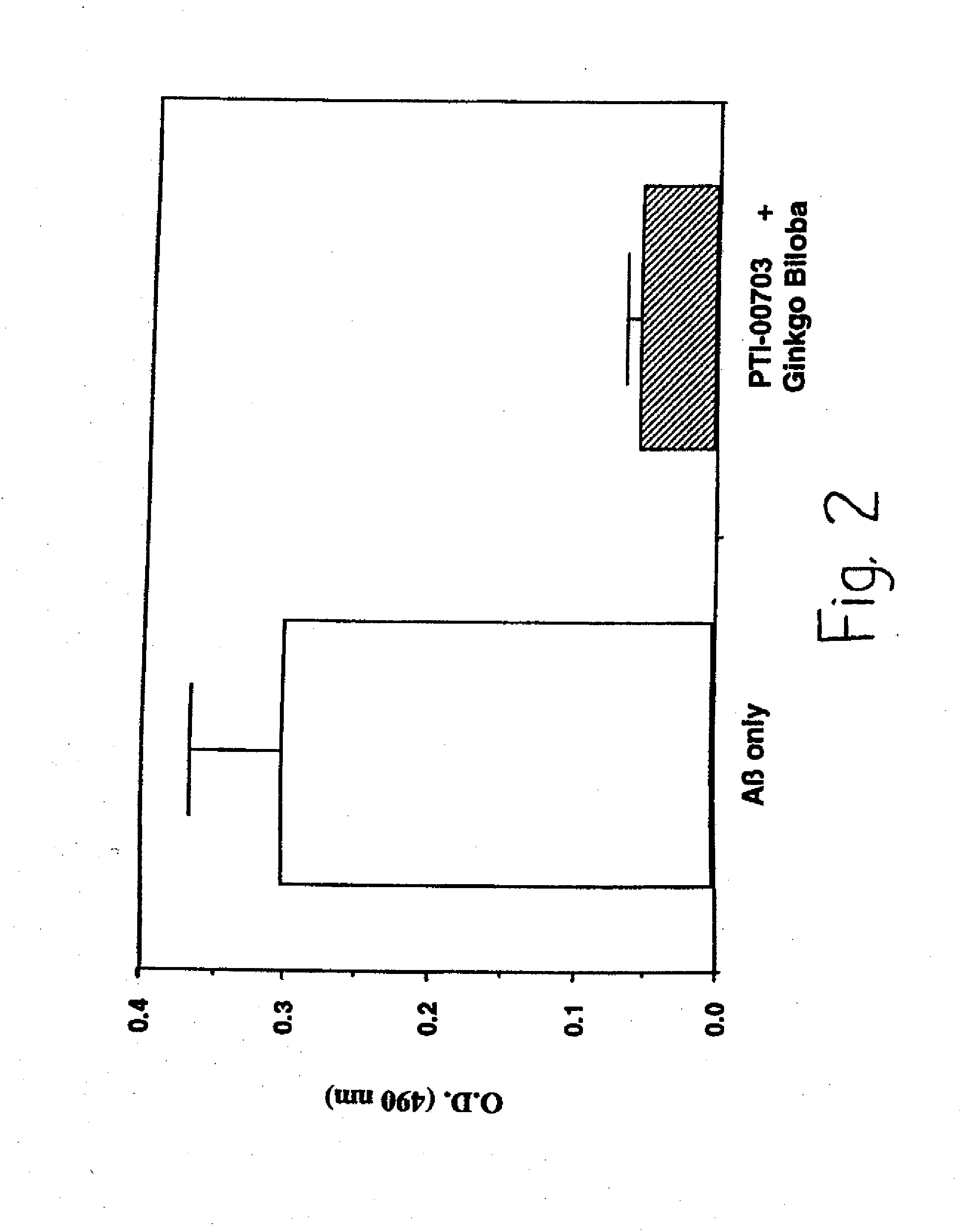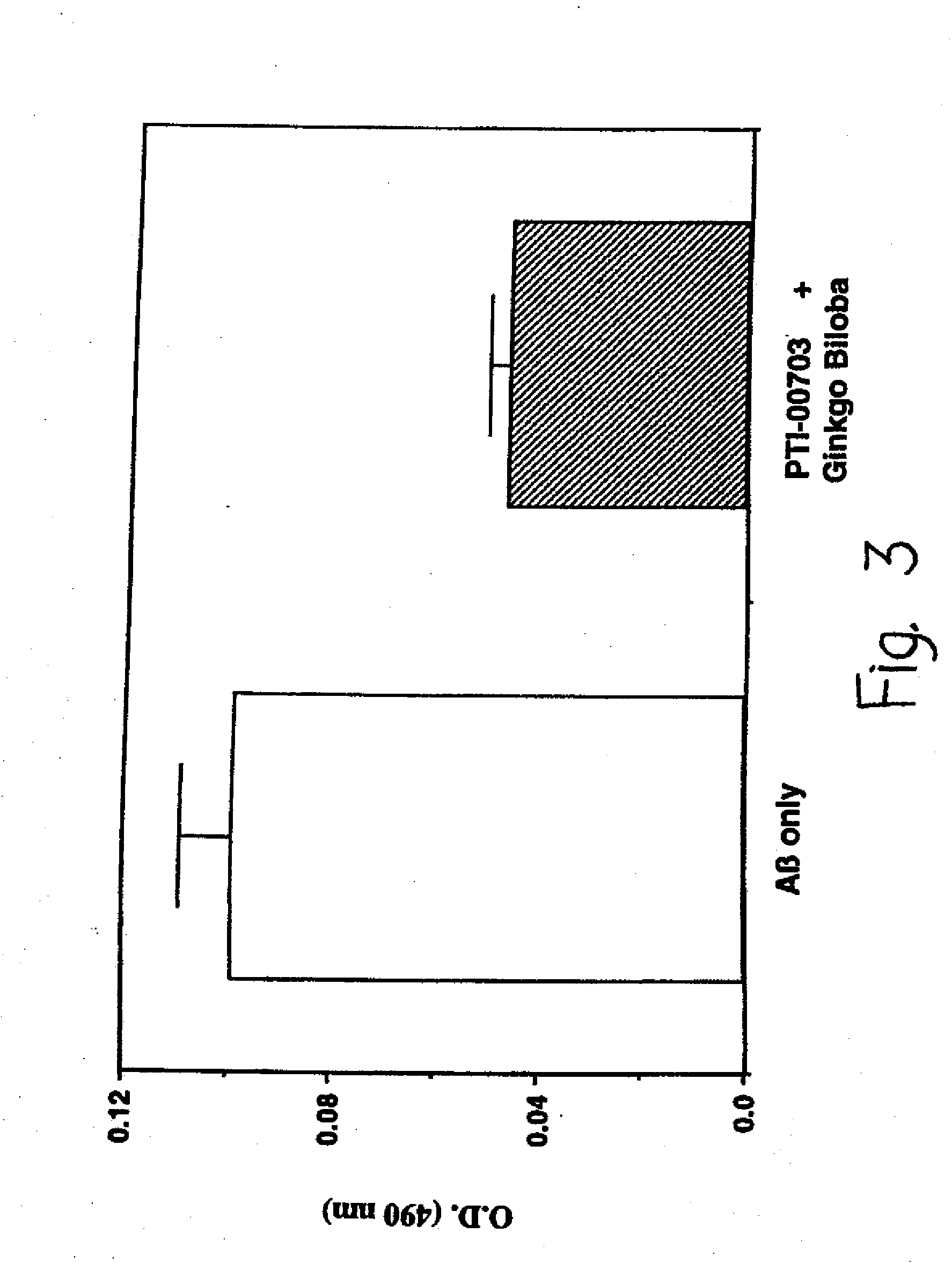Blended Compositions for Treatment of Alzheimer's Disease and Other Amyloidoses
a technology for amyloidosis and compositions, applied in the direction of drug compositions, biocide, plant/algae/fungi/lichens ingredients, etc., can solve the problems of toxicity and neuronal cell death, increased amyloid burden, and increased risk factors for amyloidosis, so as to inhibit amyloid—proteoglycan, inhibit amyloid fibril formation, and inhibit amyloid fibril growth
- Summary
- Abstract
- Description
- Claims
- Application Information
AI Technical Summary
Benefits of technology
Problems solved by technology
Method used
Image
Examples
examples
[0072]The following examples are put forth so as to provide those with ordinary skill in the art with the disclosure and description of the identification and use of commercially available Uncaria tomentosa and disclosed blend ingredients to inhibit amyloid fibril formation, inhibit amyloid fibril growth, inhibit amyloid-PG / GAG interactions, and cause dissolution / disruption of preformed amyloid fibrils. However, it should not be construed that the invention is limited to these specific examples.
[0073]The PTI-00703, is in the form of Cat's Claw Bark Powder, and the blend testing illustrated below is of 350 mg of Cat's Claw Bark Powder and 40 mg of Gingko biloba powder extract, or Gingko biloba leaf extract containing standardized 24% gingkoflavoglycosides and 6% terpene lactones; total 390 mg per test capsule.
study 1
to Assess Effects on Alzheimer's Disease Amyloid Fibril Formation
[0074]A previously described method of measuring amyloid fibril formation utilizing Thioflavin T fluorometry (H Naiki et al, Lab. Invest. 65: 104-110, 1991; H Levine III, Protein Sci. 2:404-410, 1993; H Levine III, Amyloid: Int. J. Exp. Clin. Invest. 2: 1-6, 1995; H Naiki and K. Nakakuki, Lab. Invest. 74: 374-383, 1996) was employed initially to identify whether PTI-00703 and PTI-00703 blended with Gingko biloba were capable of inhibiting Alzheimer's Aβ 1-40 amyloid fibril formation. Using this sensitive assay, any decreases or increases in fluorescence was previously shown to correlate with a decrease or increase in the amount of amyloid fibrils (H Naiki et al, Lab. Invest. 65: 104-110, 1991; H Levine III, Protein Sci. 2: 404-410, 1993; H Levine III, Amyloid: Int. J. Exp. Clin. Invest. 2: 1-6, 1995; H Naiki and K. Nakakuki, Lab. Invest. 74: 374-383, 1996), allowing one to determine the identity and extent of potential...
study 2
Testing to Assess Effects on Alzheimer's Disease Amyloid Fibril Growth
[0079]In Alzheimer's disease and other amyloidoses, amyloid fibril growth is believed to involve amyloid protein self-interactions (i.e. AB-AB interactions). Any potential effective therapeutic agent for amyloid deposition, accumulation and / or persistence should also be capable of causing an inhibition of amyloid protein self-interactions. This is important for preventing any new amyloid fibril formation when treating Alzheimer's disease patients at early stages of the disease. ELISA methodologies (i.e. solid phase binding assays) were therefore used to identify compounds which were capable of inhibiting AB-AB interactions (i.e. Alzheimer's amyloid fibril growth).
[0080]Aβ (1-40) was first labeled with biotin according to the following protocol. 1 mg of Aβ (1-40) (Bachem Inc., Torrance, Calif., USA; Lot #WL934) was dissolved in 2001 of PBS (pH 8.0) and incubated for 1 week at 37° C. The fibrillar Aβ solution was th...
PUM
 Login to View More
Login to View More Abstract
Description
Claims
Application Information
 Login to View More
Login to View More - R&D
- Intellectual Property
- Life Sciences
- Materials
- Tech Scout
- Unparalleled Data Quality
- Higher Quality Content
- 60% Fewer Hallucinations
Browse by: Latest US Patents, China's latest patents, Technical Efficacy Thesaurus, Application Domain, Technology Topic, Popular Technical Reports.
© 2025 PatSnap. All rights reserved.Legal|Privacy policy|Modern Slavery Act Transparency Statement|Sitemap|About US| Contact US: help@patsnap.com



